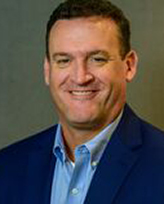Five Challenges the Healthcare Industry Needs MBAs to Solve

Baylor Professor Bradley Beauvais points to the burgeoning need for strategic business minds to confront the healthcare challenges of our time.
Five Challenges the Healthcare Industry Needs MBAs to Solve
 Bradley BeauvaisFew industries are undergoing changes as dramatic or significant as the healthcare industry. From workforce development and digital transformation to models and modalities of care, the COVID-19 pandemic reshaped a landscape that was already in flux.
Bradley BeauvaisFew industries are undergoing changes as dramatic or significant as the healthcare industry. From workforce development and digital transformation to models and modalities of care, the COVID-19 pandemic reshaped a landscape that was already in flux.
As healthcare providers grapple with a broad range of challenges, both old and new, they rely on the support of business professionals to ensure they can deliver the best care possible to their patients.
Bradley Beauvais joined the Army-Baylor University Graduate Program in Health & Business Administration as an associate professor in 2007. After nearly a decade with the program, he broadened his scope to teach courses in financial decision making for Baylor’s Dallas-based Executive MBA (EMBA) program. Through his partnership with organizations like the American College of Healthcare Executives, he keeps a finger on the pulse of the healthcare industry.
Below, he summarizes five distinct challenges that healthcare professionals need MBAs to solve:
1. Rising labor costs
A perfect storm of pandemic-era burnout, aging demographics and recruitment challenges has fueled labor shortages across the medical profession. There are simply not enough physicians and nurses to replace those who retire or leave the profession, which requires healthcare institutions to spend more on labor to ensure adequate staffing levels.
I primarily study nursing, a role which has changed dramatically in a short period of time. The pandemic prompted early retirement in a nursing workforce that was already aging, and a combination of burnout, illness and an unwillingness to be vaccinated further reduced pandemic staffing levels that have yet to fully rebound. Contract nurses fill in the gaps and earn three or four times what staff nurses earn. This disparity is financially unsustainable for many organizations, especially smaller, unaffiliated hospitals.
The physician shortage is the result of similar factors, and it is particularly acute in rural areas. While healthcare institutions can and do look internationally to recruit physicians, nurses and other in-demand healthcare workers, they must also develop more effective ways of recruiting and retaining U.S. workers. To rise to the challenge, they need professionals who are adept in marketing, building workplace culture, strategic planning and financial planning—all skills an MBA imparts.
2. Migration from fee-based to value-based care
Before 1983, the U.S. healthcare system operated according to a cost-plus pricing model, which prompted a meteoric rise in healthcare costs by allowing hospitals and providers to mark up their prices far beyond their costs. Since then, we have operated according to a fee-based model, which reimburses providers based on the number of services they provide. While well-intentioned, this system incentivizes physicians to churn through patients with more emphasis on numbers than outcomes.
Healthcare institutions need MBAs to help them make the shift to value-based care—a different way of approaching healthcare that focuses more on risks and outcomes. It is intended to be less reactionary, more preventative and more cognizant of the social determinants of health that influence population health. Turning historic ways of thinking about cost and quality on their heads will require a heavy dose of expertise in strategy and change management.
3. Shift to home-based care
Part of transitioning to a value-based healthcare system involves changing how and where healthcare is delivered. Most people are accustomed to going to a clinic to see their care team once or twice a year, losing contact the rest of the year. Improving preventative care will require a stronger emphasis on treating patients in their homes. In many cases, this will require healthcare professionals to make in-person visits. I am familiar with a multispecialty clinic in San Antonio that sends staff members to homes to run foot clinics. For a patient, having someone to take care of corns, bunions and other foot-related needs can be the difference between staying active and remaining sedentary, which has a powerful downstream effect on health outcomes and costs.
Healthcare providers are also extending the care continuum by continuing virtual visits that allow patients to access care from home. A mother of three, for example, may schedule a virtual call to consult a physician about her ill child in order to avoid exposing her other two children to potential illness in a healthcare setting. An elderly couple, likewise, will remain safer and healthier by meeting with a provider over a video call than driving through traffic and braving an icy parking lot on their visit to the clinic. Digital advances have enabled them to use a small diagnostic kit to record and transmit weight, blood pressure and oxygen levels from the comfort of their home.
I recently heard a healthcare provider ask an intriguing question: If their 70-year-old patient is at home without air conditioning on a 120-degree day, does it count as “healthcare” to buy her an air conditioning unit? The black-and-white answer is no—it is not healthcare. But that $400 intervention will alleviate suffering and avoid a $10,000 visit to the emergency room. As the healthcare industry evolves, it needs people with the skills to untangle the logistical and financial challenges of providing more creative modalities of care.
4. Making sense of data
Healthcare institutions have only begun to realize the immense potential of new digital systems, particularly those that leverage artificial intelligence (AI) to collect and analyze data. A new AI-enabled ultrasound platform, for example, might locate tumors with a much lower false positive rate than ever before, preventing invasive, unnecessary treatment. The MBA skillset is critical to being able to evaluate different systems and capabilities and work with stakeholders to select and implement new systems. Another strength of an MBA program is its emphasis on training students to analyze and synthesize information from the massive amount of data that is currently being collected. Healthcare data, whether clinical or financial, is only useful if there is a team of people who can analyze, interpret and convey its significance in a meaningful way.
5. Responding to outside disruptors
Tech companies and venture capitalists are wading into healthcare, mainly fulfilling primary care functions like diagnostics and blood draws. At the same time, health plans are quickly expanding to become “payviders.” Disruptors like Amazon and CVS would not have an opening if the healthcare system was operating in the most efficient, cost-effective way possible. Some MBAs will help traditional healthcare providers compete with outside disruptors by better understanding and meeting the needs of their patients. This may involve adopting and co-opting some of the same disruptive technology used by their competitors. Other MBAs will work for the disruptors, building capabilities for new technology and ensuring that models of care are financially sustainable and safe for patients.
Accounting for 20 percent of U.S. GDP, the healthcare industry is ripe for innovation and change. For anyone interested in improving the healthcare system, there is no shortage of problems to tackle. Fortunately, Baylor’s MBA programs equip students with the right blend of skills to move the needle in the right direction.
What's Next
Are you passionate about improving the U.S healthcare system? Learn more about Baylor’s Dallas-based EMBA program with a concentration in Healthcare Administration by clicking here or fill out the form below to speak directly with an admissions advisor.